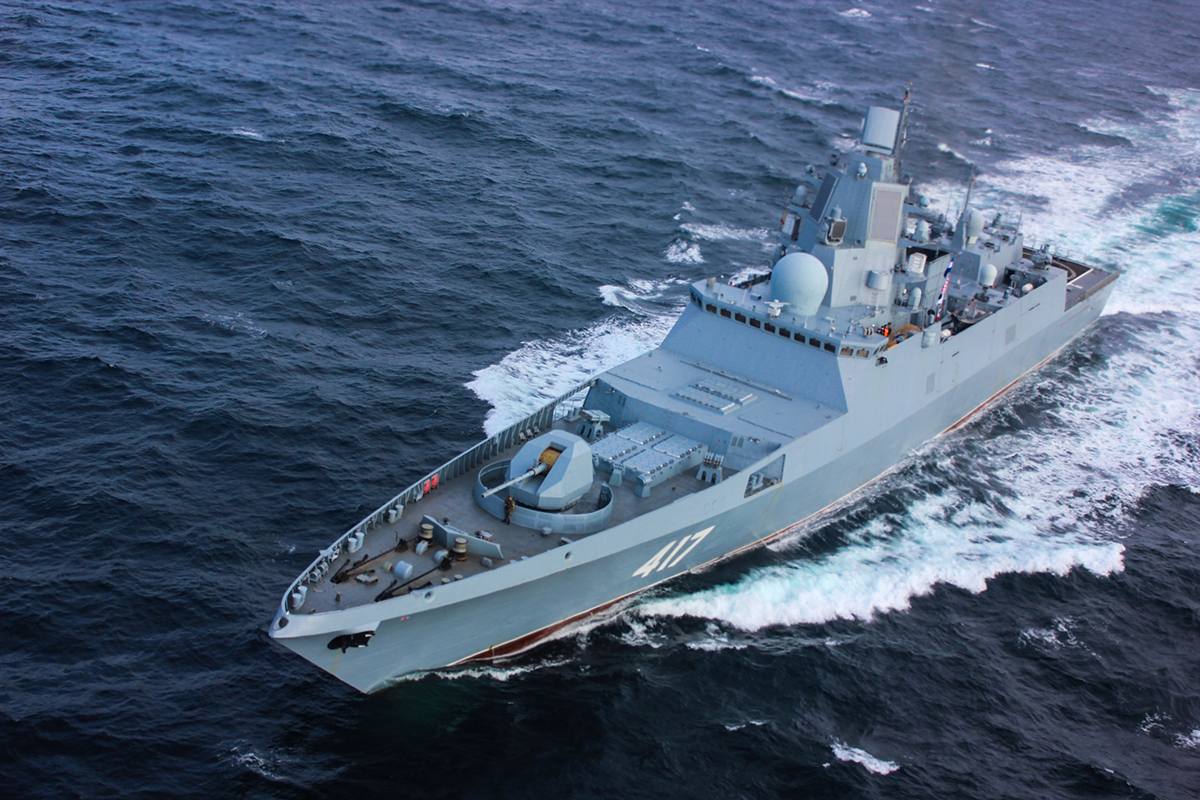Admiral Gorshkov Carrier - This article is about the Kyiv-class aircraft carriers. For the flagship of the class, see Soviet aircraft carrier Kyiv. For other ship classes, see Kiev class. For other ships, see Kiev (ship).
This article includes a list of general references, but does not have proper inline citations. Please help improve this article by providing more specific citations. (January 2013) (Learn how and when to remove this template message)
Admiral Gorshkov Carrier

The Kyiv class, Soviet project designation 1143 Krechyet (girfalcon), was the first class of two fixed-wing aircraft carriers (Soviet-class heavy aircraft) built for the Soviet Union Navy.
Atomic Squadron Of Admiral Gorshkov
Launched in 1970, the first ship of her class, Kyiv, was based in part on a full-deck ship design proposed in the Orel Project. Initially, the Soviet Navy wanted a supercarrier similar to the American Kitty Hawk class. However, the smaller Kyiv design was preferred
Unlike most NATO aircraft carriers, such as most US or British aircraft carriers, the Kyiv class is a combination of a cruiser and an aircraft carrier. In the Soviet Navy, this ship class was referred to as a "heavy aircraft cruiser" (Russian: Тяжелые авианесущие крейсера) rather than an aircraft carrier. Although this designation allows ships to pass through the Turkish strait, the 1936 Montreux Convention prohibits the passage of aircraft carriers weighing more than 15,000 tons through the strait.
The ships were designed with a large island superstructure on the starboard side, with a flight deck angle of 2/3 of the deck length; The forward deck was occupied by heavy surface-to-surface and surface-to-surface missile weapons. The purpose of the Kyiv class was to support strategic missile submarines, other surface ships and naval aircraft; It could be measured in anti-aircraft, anti-submarine and surface warfare.
The Soviet Union built and commissioned a total of four Kyiv-class aircraft carriers to serve in the Soviet and Russian navies. The first two ships were sold to China as museums and the third ship was scrapped. The fourth ship, Admiral Gorshkov, was sold to the Indian Navy in 2004 and is currently in active service as INS Vikramaditya after many years of modifications and refit work.
Soviet Aircraft Carrier Baku
Sold to a Chinese company in 1996, it has been a Tianjin theme park since 2004. It has been further developed and converted into a luxury hotel since 2014. Long-range air surveillance radars, LESORUB-E, Resistance-E radar complex, CCS MK II communication complex and Link II tactical data system
She is a modified Kyiv-class aircraft carrier and is the flagship of the Indian Navy. It was launched in 2013.
Originally built as Baku and commissioned in 1987, the aircraft carrier was decommissioned in 1996 by the Soviet Navy and later the Russian Navy (as Admiral Gorshkov).

That carrier was invested by India on January 20, 2004, after years of negotiations, with the final sale price of the weapon being $2.35 billion.
Russia's Only Aircraft Carrier Is Armed To The Teeth
On 14 June 2014, Indian Prime Minister Nardra Damodar Modi officially named INS Vikramaditya to the Indian Navy and dedicated it to the nation.
Baku entered service in 1987, attacked Admiral Gorshkov in 1991, but was decommissioned in 1996 because it was too expensive to operate on a post-Cold War budget. This caught the attention of India, which was looking for a way to expand its carrier aviation capabilities.
On January 20, 2004, after years of negotiations, Russia and India signed an agreement to sell the ship. While the ship will be free, India will pay $800 million to modernize and upgrade the ship and an additional $1 billion for aircraft and weapon systems. The Navy considered equipping the ship with E-2C Hawkeyes but decided against it.
The deal also included the purchase of 12 Mikoyan MiG-29K "Fulcrum-D" single-seat (item 9.41) and four twin-seat MiG-29KUB aircraft (with an option for 14 more) for US$1 billion, six Kamov Ka. -31 "Helix" reconnaissance and anti-submarine helicopters, torpedo tubes, missile systems and artillery units. Facilities and procedures for training pilots and technical staff, delivery of simulators, spare parts and maintenance of facilities at Indian Army facilities were also part of the contract.
The Sad Story Of How This Soviet Aircraft Carrier Ended Up Rotting In A Landlocked Chinese Lagoon
The upgrade included removing all of the ship's forward cannon and missile launcher tubes to make way for a "short velocity but recovery arrested" (STOBAR) configuration.
The delivery date of INS Vikramaditya was August 2008, allowing the carrier to enter service at the time of the retirement of INS Viraat, the Indian Navy's only light carrier. While Viraat's retirement was delayed to 2010-2012,
Latency issues, along with persistent cost overruns, led to high-level diplomatic exchanges. India eventually agreed to pay an additional $1.2 billion for the project, doubling the original cost.

However, ongoing difficulties in Vikramaditya's delivery schedule pushed the planned delivery to 2013. Also, the Vikrant class aircraft carrier was delayed by at least a year and was expected to be commissioned in 2013 from 2012.
File:aircraft Carrier \
In July 2008, it was reported that Russia had to raise the price by around $2 billion, blaming unexpected cost overruns for the ship's deteriorating condition and citing a US$3-4 "market price" for a new medium-sized carrier. bn.
India paid $400 million in November 2008. But Russia has repeatedly threatened to scrap the deal if India doesn't pay for the hike.
In December 2008, Indian government sources reported that the Cabinet Committee on Security (CCS) finally decided to buy Admiral Gorshkov as the best option.
India's Inspector General of Finance and Auditor General (CAG) has criticized that the Vikramaditya will be a second-hand warship with a limited life and will cost 60% more than a new ship. There was also a greater risk of delivery delays.
Soviet Aircraft Carrier Admiral Gorshkov
Admiral Sureesh Mehta, Commander of the Indian Navy, said, "Can't give an opinion on the CAG crore? If you can, I'll sign a check immediately."
A statement by the Commander of the Navy at the time showed that the final deal could be worth more than $2 trillion. Asked about the CAG's finding that no risk analysis was done before the ships were launched, he said: "You can be sure there is no such thing. We are definitely looking into the situation. The ship since the late 90s."
On 2 July 2009, Russian President Dmitri Medvedev said that the upgrade of the aircraft carrier should be completed as soon as possible so that it can be delivered to India in 2012.

On December 7, 2009, Russian sources stated that final terms had been agreed, but no delivery date had been set.
Admiral Gorshkov Frigate Hi Res Stock Photography And Images
On December 8, 2009, India and Russia were reported to have agreed on a price of $2.2 billion, ending the deadlock over the Admiral Gorshkov price agreement. Moscow asked for $2.9 billion for the aircraft carrier, triple what the two sides initially agreed to in 2004. On the other hand, New Delhi asked to lower the price again, to 2.1 billion dollars.
The two governments had fixed the price of the Admiral Gorshkov at $2.35 billion on March 10, a day before Russian Prime Minister Vladimir Putin's two-day visit to India.
In April 2010, a scandal related to the project erupted when it was reported that a senior Indian Navy officer had been blackmailed to influence Admiral Gorshkov's negotiations over the cost to India.
Admiral Sukhjinder Singh was a key figure, working as the chief project officer, overseeing the repair of the ship. He was fired for this incident.
Future Is Cloudy For Russian Carrier Aviation
By June 2010, about 99% of the structural work and about 50% of the wiring work had been completed. Almost all major equipment has been installed, including engines and diesel generators.
All reconstruction work was completed in Severodvinsk, Russia. However, it was delayed for three years because the number of cables needed was underestimated.
To resolve the issues, an expert-level discussion was held between India and Russia on technical and financial issues.

The MiG-29K entered operational service with India in February 2010. A compromise was reached and India would pay an additional undisclosed amount. Instead of fixing the old systems, Russia would install new systems.
Back In The Game
On 1 June 2010, The Times of India reported that a naval official said: "After three years of bitter wrangling over Gorshkov's revised replacement costs, India earlier this year allocated only $974 to the previous agreement signed in January 2004." Accepting $2.33 billion, which is $2.33 billion. To this end, Russia has appointed a high-level commission to oversee the work on the aircraft carrier." The ship was due to undergo port trials in early 2011 for delivery to India around December 2012.
Dock testing began on March 1, 2011. These tests focused on major power generation units and radio electronic weapon systems manufactured in India.
On April 19, 2012, it was reported that all internal systems were operational and the ship was completely disconnected. the vessels
Russian carrier admiral kuznetsov, admiral gorshkov frigate, gorshkov aircraft carrier, admiral gorshkov, carrier admiral, admiral sergey gorshkov, gorshkov, black shoe carrier admiral, admiral kuznetsov aircraft carrier, admiral gorshkov class frigate, admiral gorshkov aircraft carrier, admiral sergei gorshkov
0 Comments